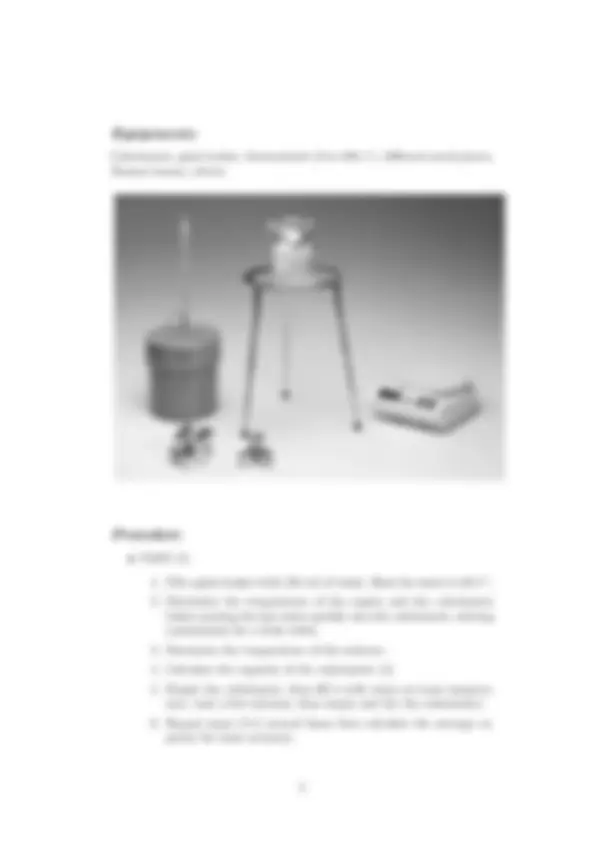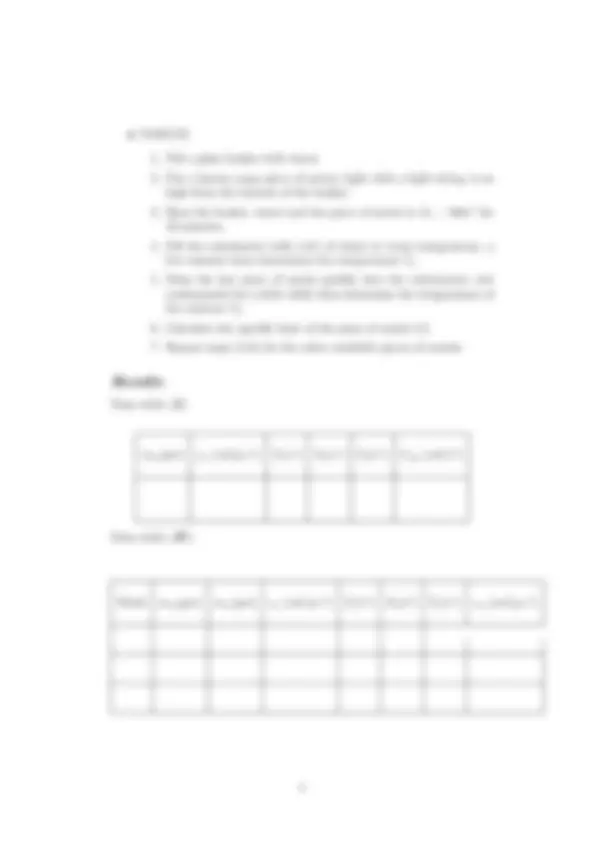




Study with the several resources on Docsity

Earn points by helping other students or get them with a premium plan


Prepare for your exams
Study with the several resources on Docsity

Earn points to download
Earn points by helping other students or get them with a premium plan
Community
Ask the community for help and clear up your study doubts
Discover the best universities in your country according to Docsity users
Free resources
Download our free guides on studying techniques, anxiety management strategies, and thesis advice from Docsity tutors
Heat capacity of the calorimeter, specific heat capacity of aluminium, iron and brass.
Typology: Lecture notes
1 / 4

This page cannot be seen from the preview
Don't miss anything!



Different substances require different quantities of heat to produce a given temperature change. For example, about three and one-half times as much heat is needed to raise the temperature of 1 kg of iron through a given temperature interval ∆T as is needed to raise the temperature of 1 kg of lead by the same amount. This material behavior is characterized quan- titatively by specific heat, which is the amount of heat necessary to raise the temperature of 1 gram of the substance 1 degree Cel- sius. Thus, iron has a greater specific heat than lead The specific heat of a material is specific or characteristic for that material. As can be seen from the definition, the specific heat of a given material can be determined by adding a known amount of heat of a known mass of material and not- ing the corresponding temperature change. The purpose of this experiment is to determine the specific heats of some common metals by calorimetry methods.
The change in temperature ∆T of a substance is proportional to the amount of heat ∆Q added (or removed) from it:
∆Q ∝ ∆T, (1)
In equation form, we may write
∆Q = C ∆T. (2)
Where the constant of proportionality C is called the heat capacity of the substance. However the amount of heat required to change the temperature of an object is also proportional to the mass of the object. Hence, it is convenient to define specific heat capacity c (or simply specific heat):
c =
m
Which is the heat capacity per unit mass of a substance. Thus, equation (2) becomes:
∆Q = c m ∆T or c =
m∆T
And the specific heat is then the amount of heat (in calories) required to change the temperature of 1 g of a substance 1 c◦. The calorie unit of heat is then the amount of heat required to raise the temperature of 1 g of water 1 c◦. By definition, then, water has a specific heat of 1 cal/g c◦.
c =
m∆T
1 cal (1g) (1c◦)
= 1cal/g c◦
The heat capacity of a calorimeter and the specific heat of a substance can be determined experimentally by measuring the temperature change of a given mass of substance produced by a quantity of heat. This is done indi- rectly by a calorimeter procedure known as the method of mixtures. If several substances at various temperatures are brought together, the hotter substances will lose heat and the colder substances will gain heat until all the substances reach a common equilibrium temperature. If the system is insulated so that no heat is lost to the surroundings, then by the conserva- tion of energy, the heat lost is equal to the heat gained. In part (I) of this experiment an empty calorimeter at room temperature is filled with a known mass of hot water, then the mixture temperature is measured. So we may write
heat gained = heat lost
∆Qcalorimeter = ∆Qwater
or C∆Tcalorimeter = m × c × ∆Twater (4)
In part (II) hot metal is added to water in a calorimeter cup and the mix- ture is stirred until the system is in thermal equilibrium. The calorimeter isolates the system from losing heat. In mathematical form, we may write:
heat lost = heat gained
∆Qmetal = ∆Qcalorimeter + ∆Qwater
or mm × cm × (Th − Tf ) = (Ccal + mw × cw) × (Tf − Tc) (5)
Where Th is the initial temperature of the hot metal, Tc is the initial tem- perature of the colder water and calorimeter cup and stirrer, and Tf is the final intermediate equilibrium temperature of the system.
Data table (I ):
mw(gm) cw (cal/g c◦) Tc(c◦) Th(c◦) Tf (c◦) Ccal (cal/c◦)
Data table (II ):
Metal mm(gm) mw(gm) cw (cal/g c◦) Tc(c◦) Th(c◦) Tf (c◦) cm (cal/g c◦)